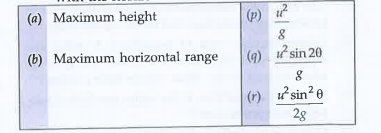A ball is thrown from the ground with velocity u at an angle θ with horizontal. If the coefficient of restitution is e , find the time of flight , the maximum height and the horizontal range after the first collision.
To solve the problem of a ball thrown from the ground with an initial velocity u at an angle θ with the horizontal, and considering the coefficient of restitution e, we will find the time of flight, maximum height, and horizontal range after the first collision with the ground.
1. Understanding the Components of Motion:
- The initial velocity u can be broken down into horizontal and vertical components:
- Horizontal component: ux=ucosθ
- Vertical component: uy=usinθ
2. Time of Flight Before Collision:
- The time taken to reach the ground (before the first collision) can be calculated using the vertical motion equations. The total time of flight T can be found using:
T=2uyg=2usinθg
- This is the time taken to reach the maximum height and then fall back to the ground.
3. Velocity After Collision:
- Upon collision with the ground, the vertical component of the velocity is reversed and multiplied by the coefficient of restitution e:
- New vertical component after collision: vy=−euy=−eusinθ
- The horizontal component remains unchanged: vx=ux=ucosθ
4. Time of Flight After Collision:
- The time of flight after the first collision until it hits the ground again can be calculated using the new vertical component:
T′=2|vy|g=2(eusinθ)g
5. Maximum Height After Collision:
- The maximum height H reached after the first collision can be calculated using:
H=(vy)22g=(eusinθ)22g=e2u2sin2θ2g
6. Horizontal Range After Collision:
- The horizontal range R after the first collision can be calculated using the horizontal component of the velocity and the time of flight after the collision:
R=vx⋅T′=(ucosθ)⋅(2eusinθg)
- Simplifying this gives:
R=2eu2sinθcosθg=eu2sin2θg
Final Answers:
- Time of Flight after First Collision:
T′=2eusinθg
- Maximum Height after First Collision:
H=e2u2sin2θ2g
- Horizontal Range after First Collision:
R=eu2sin2θg
- The initial velocity u can be broken down into horizontal and vertical components:
- Horizontal component: ux=ucosθ
- Vertical component: uy=usinθ
- The time taken to reach the ground (before the first collision) can be calculated using the vertical motion equations. The total time of flight T can be found using:
T=2uyg=2usinθg
- This is the time taken to reach the maximum height and then fall back to the ground.
- Upon collision with the ground, the vertical component of the velocity is reversed and multiplied by the coefficient of restitution e:
- New vertical component after collision: vy=−euy=−eusinθ
- The horizontal component remains unchanged: vx=ux=ucosθ
- The time of flight after the first collision until it hits the ground again can be calculated using the new vertical component:
T′=2|vy|g=2(eusinθ)g
- The maximum height H reached after the first collision can be calculated using:
H=(vy)22g=(eusinθ)22g=e2u2sin2θ2g
- The horizontal range R after the first collision can be calculated using the horizontal component of the velocity and the time of flight after the collision:
R=vx⋅T′=(ucosθ)⋅(2eusinθg)
- Simplifying this gives:
R=2eu2sinθcosθg=eu2sin2θg
- Time of Flight after First Collision:
T′=2eusinθg
- Maximum Height after First Collision:
H=e2u2sin2θ2g
- Horizontal Range after First Collision:
R=eu2sin2θg
Topper's Solved these Questions
Similar Questions
Knowledge Check
A ball is thrown with a velocity of u making an angle θ with the horizontal. Its velocity vector normal to initial vector (u) after a time interval of
AusinθgBugcosθCugsinθDucosθgA ball is dropped from a height h on to a floor . If the cofficient of restitution is e, calculate the height the ball first rebounds ?
Ae2hBe√hCehD√ehA ball falls from a height of 10m on to a horizontal plane. If the coefficient of restitution is 0.4, then the velocity with which it rebounds from the plane after second collision is
A2.24ms−1B5.6ms−1C2.8ms−1D0.9ms−1
A ball is thrown with speed u at an angle θ with horizontally. After how much time it will move perpendicular to the initial direction of motion.
View SolutionA ball is projected from the ground at some angle with horizontal. Coefficient of restitution between the ball and the ground is e. Let a, b and c be the ratio of times of flight, horizontal range and maximum height in two successive paths. Find a, b and c in terms of e.

View SolutionA small ball is dropped from rest from height 10 m on a horizontal floor. If coefficient of restitution between ground and body is 0.5 then find the maximum height it can rise after collision.
View SolutionA ball is dropped from height 'H' onto a horizontal surface. If the coefficient of restitution is 'e' then the total time after which it comes to rest is
View SolutionA projectile is thrown with velocity u making an angle θ with the horizontal. Its time of flight on the horizontal ground is 4 second. The projectile is moving at angle of 45∘ with the horizontal just one second after the projection. Hence the angle θ is (take g=10m/s2)
View Solution

